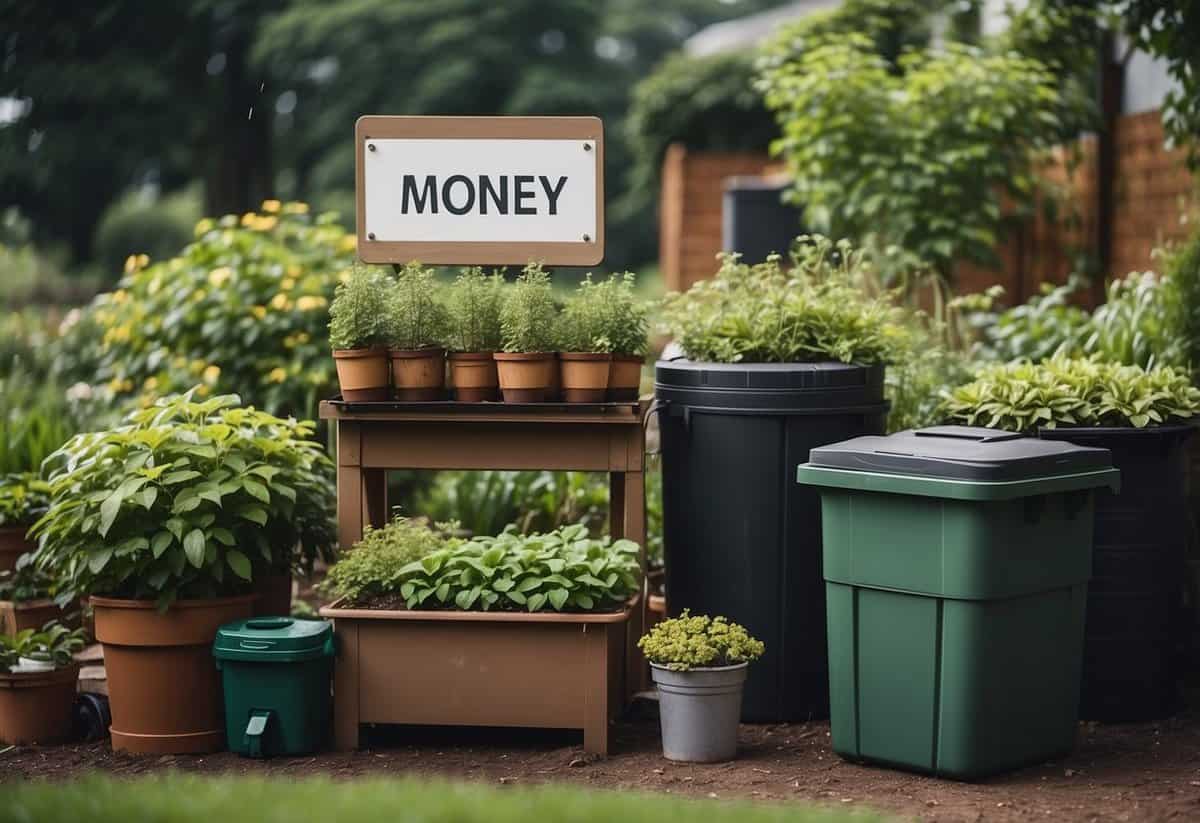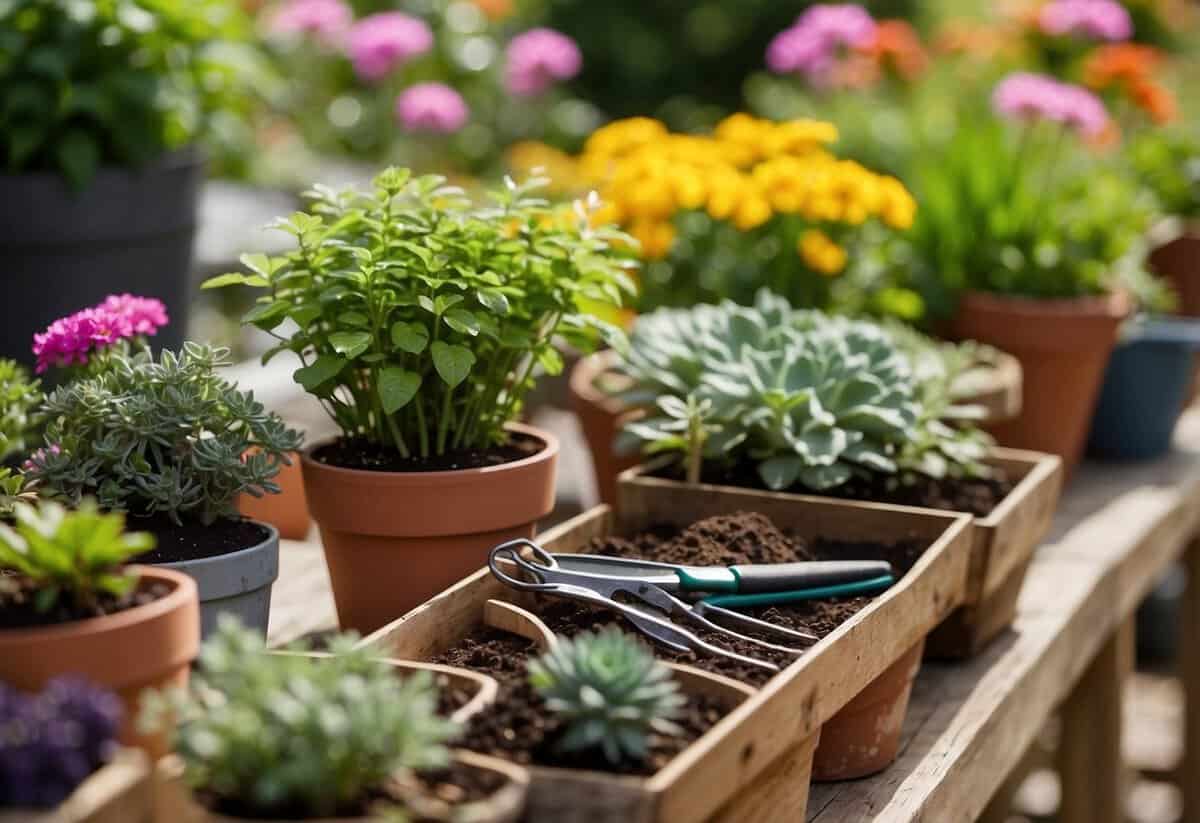Garden Money Saving Tips: Smart Ways to Cut Costs
Gardening is a rewarding hobby that adds beauty to your home and provides fresh produce. As enjoyable as gardening is, it can get expensive quickly, especially if you’re not careful with your spending.

How can you maintain a beautiful and productive garden without breaking the bank? This article will offer practical tips and ideas to help you save money while still enjoying all the benefits of gardening.
1) Use Fewer Pesticides

Hand-picking pests is a simple way to reduce the use of pesticides in your garden. It’s a great alternative to buying chemical products, and it’s free!
Creating a strong stream of water to hose off insects from plants can also be effective. Sometimes, a bucket of soapy water is all you need to handle small pest problems.
Consider growing pest-resistant plant varieties. These plants are naturally less appealing to pests, which means you won’t need to use as many chemicals to keep your garden healthy and thriving.
2) Compost kitchen scraps

Composting kitchen scraps is a fantastic way to save money and reduce waste. You can turn vegetable peels, fruit rinds, eggshells, and coffee grounds into rich compost for your garden.
Avoid composting meat, dairy, and oils. These can attract pests and create bad odors. Instead, focus on plant-based scraps, which break down quickly and enrich your soil.
Start by collecting your kitchen scraps in a small bin or bucket. When it’s full, empty it into an outdoor compost pile or compost bin. This method is easy and cost-effective, turning waste into valuable garden gold.
For more details, check out how to compost kitchen scraps.
3) Collect rainwater

Collecting rainwater is an easy way to save money in your garden. Instead of using tap water, which costs money, you can use the water that nature provides for free.
Set up a barrel under your gutter downspout. This will collect rainwater that runs off your roof. It’s simple and effective.
Old barrels add a rustic charm to your garden while also being practical. You can find some at local home and garden stores. This not only saves money but also helps the environment.
4) Plant Perennials

Planting perennials is a great way to save money. These plants come back year after year, so you won’t need to buy new plants each season. They also take care of themselves better than annuals.
Perennials can fill your garden with color and texture. Try using plant exchanges to get new varieties for free or trade. You can connect with other gardeners and share ideas.
5) DIY Garden Beds

Building your own garden beds can save money and be fun. You can use untreated wood to create simple raised beds. They are sturdy and safe for plants.
Another idea is repurposing old pallets. Make sure they are clean and untreated, then stack them to form the sides of your bed. Fill with compost-rich soil.
Using materials like bricks or stones from your yard can also work. They add a natural look and are often free. Look around your space; you might already have what you need to build a great garden bed.
6) Repurpose containers

Using repurposed containers can save you money and give your garden a unique look. You can transform old footwear and clothing into quirky plant containers, giving new life to items you might otherwise throw away. This not only adds charm to your garden but is also eco-friendly.
Old kitchen items like vintage sinks can also make charming plant containers. Head to salvage yards to find these treasures. Even everyday items like bathtubs, toolboxes, and wheelbarrows can become creative garden planters. Get creative and have fun with it!
7) Shop end-of-season sales

Shopping at the end of the season is a great way to save money on garden supplies. Many stores offer big discounts on plants, tools, and other gardening essentials.
You can find bargains on perennials and other plants that you can divide at home, making your garden even fuller. Plus, stocking up on tools and supplies now means you’ll be ready for next season.
End-of-season sales are perfect for budget-conscious gardeners looking to maximize their savings. Enjoy the discounts and get a head start on next year’s garden!
8) Start plants from seeds

Starting plants from seeds is a smart way to save money in your garden. Seeds are typically cheaper than buying young plants. You can get a lot more seeds for the price of just one established plant. Plus, there’s a wide variety of seeds available so you can try growing different kinds of plants.
To start, you can use containers you already have at home, such as egg cartons or yogurt cups. Make sure they have drainage holes. Using potting soil is best, but you can also make your own compost to save even more.
Another way to save is by collecting seeds from your existing plants. Save seeds from healthy plants to use next season. Make sure the seeds are dried properly before storing them. This can help cut down on costs and ensures you have a supply ready for the next planting season.
9) Use mulch to retain moisture

Adding mulch to your garden can save both time and water. It works by keeping the soil moist for longer periods. This means you won’t have to water as often.
Mulch also keeps the roots of your plants cool. This is especially helpful during hot summer days. To learn more about proper mulch application, read this guide.
In addition, using mulch can make your garden beds look tidy. Different materials like bark mulch, wood chips, and shredded leaves work well for this purpose.
10) Swap Plants with Friends

Swapping plants with friends is a great way to add variety to your garden without spending money. You can trade seeds, cuttings, or even fully-grown plants.
Not only do you save money, but you also get to share tips and learnings with fellow gardeners. It’s a win-win!
Organizing a plant swap is easy. Invite a few friends, and everyone can bring their extras to trade. This way, you all get new plants and build a stronger gardening community. Interested in the benefits of plant swaps? Learn more about flower swaps and how to organize one with your friends.
Choosing The Right Plants

Selecting the appropriate plants for your garden can greatly impact how much you spend and maintain your garden. By choosing perennials and native plants, you can save time and money while ensuring your garden thrives.
Perennials vs. Annuals
When planning your garden, it’s essential to decide between perennials and annuals. Perennials return year after year, which means you don’t need to replant them. This can save you money and effort in the long run.
For example, plants like daylilies and hostas are hardy and require less maintenance. They can fill your garden with color every year, reducing the cost of buying new plants each season. Moreover, perennials usually need fewer fertilizers and pesticides once they are established.
Annuals, on the other hand, complete their life cycle in one growing season and need to be purchased anew each year. While they can add vibrant colors and diversity, consider using them sparingly to manage costs.
Native Plants
Native plants are adapted to the local environment, making them easier and cheaper to maintain. They typically require less water and fertilizer, thriving in the natural soil and climate conditions. This can lower your garden’s water bills and reduce the need for chemical fertilizers.
Plants like purple coneflower and black-eyed susans are excellent choices. They attract local wildlife, benefiting the ecosystem.
By choosing native plants, you’re more likely to have a successful garden with minimal effort. They are better geared towards surviving local pests and diseases, which means you will use fewer pesticides, further lowering your gardening costs.
By focusing on perennials and native plants, you can create a beautiful, sustainable garden that saves you money and effort year after year.
Watering Efficiently

Watering your garden efficiently can save you money and help your plants thrive. Using methods like drip irrigation systems and rainwater harvesting can ensure that every drop counts.
Drip Irrigation Systems
Drip irrigation systems deliver water directly to the roots of your plants. This reduces waste and makes sure plants get the water they need without overwatering. You can set up a drip irrigation system with a timer to water at the best times, such as early morning or evening. This method also minimizes evaporation.
Installing a drip system is simple. Use tubing and emitters to target specific plants. This setup is ideal for gardens and flower beds. Not only does it save water, but it also promotes healthier plant growth by watering precisely where it’s needed.
Rainwater Harvesting
Rainwater harvesting involves collecting and storing rainwater for garden use. Using rain barrels to capture runoff from your roof is an easy way to start. Place barrels under downspouts to collect water during storms. With a filtration system, this water can be used later for irrigation.
Rainwater is free and often contains fewer chemicals than tap water. This makes it better for your plants. By using rainwater, you reduce your dependence on municipal water supplies, lower your water bill, and help conserve a vital resource. Investing in a good setup will pay off in the long run, both for your wallet and the environment.
Composting At Home

Composting at home reduces waste and creates free fertilizer. It’s easy to start with the right setup and a bit of regular maintenance.
Compost Bins
A compost bin is a container for organic waste. It helps decompose items like fruit scraps and yard clippings. You can buy a tumbler or build one yourself. Place it in a sunny spot to speed up the process.
To make compost, alternate layers of “greens” and “browns.” Greens include items like vegetables and fruit peels. Browns are things like dry leaves and cardboard. Aim for about three to four times more browns than greens to keep the balance right.
Keep the pile moist, similar to a damp sponge. Turn the pile regularly to ensure proper aeration. In a few months, you’ll have rich compost for your garden.
Vermicomposting
Vermicomposting uses worms to speed up the composting process. It’s perfect for indoors or small spaces. You’ll need a worm bin and some red wiggler worms. They are efficient at breaking down food waste.
Create bedding for the worms with shredded newspaper, coconut coir, or cardboard. Add vegetable scraps and fruit peels as food for the worms. Avoid meat, dairy, and oily foods as they can attract pests.
Keep the bin in a cool, shaded area. Maintain moisture, but avoid overwatering. The worms will digest the waste and produce nutrient-rich compost called worm castings. This compost is great for gardens and potted plants. You can also use worm tea, the liquid that drains from the bin, as a natural fertilizer.







